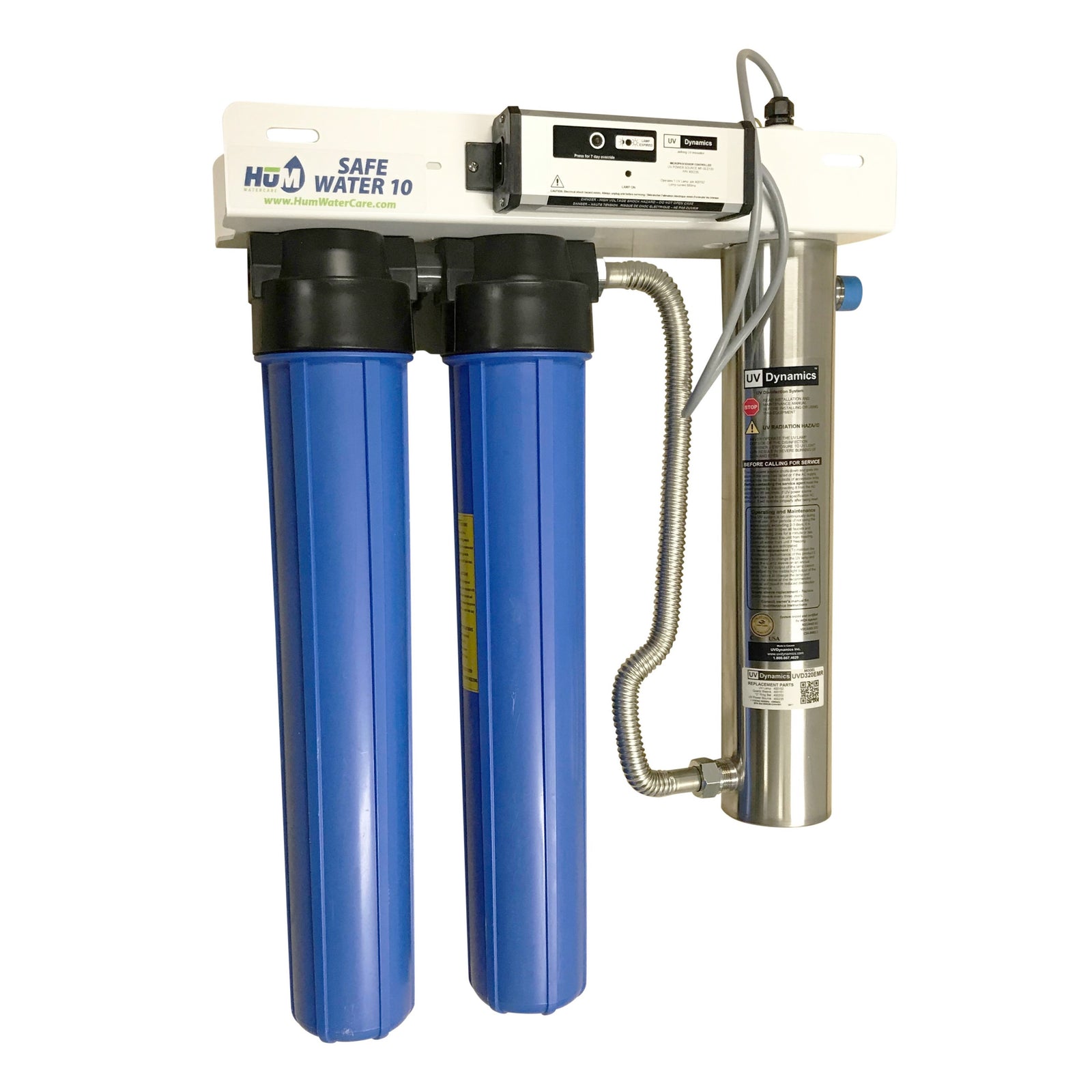
One of the great aspects of Ultraviolet or UV water disinfection for well or surface water is that it’s a light disinfection process and does not add any potentially harmful chemicals to your family’s water. UV systems will kill all the bacteria in your water as the water passes through the UV, but what about the potentially infected water that is downstream of the UV?
Since there isn’t a disinfection residual, it’s important that the entire plumbing system located after the UV be chemically disinfected initially to ensure that the water is free from any bacteriological contaminants. The disinfection process must be performed as part of the UV installation and repeated whenever the UV is shut down for service, it’s operated without power (like during a power outage), or had been inoperative for any reason.
1) Shut off the upstream water supply that feeds water into the Ultraviolet Disinfection System and depressurize your water system by opening a downstream faucet.
2) Remove the pre-filter cartridge from the sump nearest the UV chamber and fill the sump with 2-3 cups of household (5.25%) bleach (chlorine) and close the sump. At all times during this process, make sure the UV system (and lamp) is turned on and operational!
3) Re-pressurize water system by turning the water back on.
4) Starting with the faucet farthest away and working your way back, open each faucet and allow cold water to run until you detect chlorine using hot tub test strips, as shown in this YouTube video of mine https://youtu.be/1dD2eavyb5E and then immediately shut the faucet off and repeat the process for each faucet and fixture. You must ensure that all water sources located after the UV, including outside faucets, dishwashers, shower heads, washing machines, connections to refrigerators, toilets, etc., pass chlorinated water.
5) Once you‘ve finished with the cold water, repeat the whole process with the hot water. The hot water may need to run for quite awhile before you detect the chlorine because of the large quantity of water in the hot water tank which will dilute the chlorine. Again, make sure you get a chlorine residual at every hot water source.
6) Once all the water locations have passed chlorine, you will need to leave the chlorine sit in the pipes for a period of 4 hours. Do not use any water during this time. The chlorine needs this contact time to make sure it kills all of the bacteria in your home, cottage or cabin.
7) Reinstall the pre-filter cartridge into the filter housing.
8) After 4 hours, flush the chlorine solution from the system until the chlorine smell is gone. Don’t be surprised if there is a lot of discoloured water coming out of the faucets. Make sure that each fixture that was disinfected is completely flushed of chlorine.
Do not consume water until complete system has been flushed. Run the washing machine without clothes in it to flush out all of the chlorine.
Video Transcript
Gary The Water Guy:
When installing an ultraviolet disinfection system, you've probably noticed in the instructions, it says to make sure you disinfect the plumbing. And then as in the instructions, it explains how to do that. But boy, does it ever seem complicated? And wait a second. I thought that's why you bought this system in the first place. Well, in this video, I'm going to explain to you why you need to do it, how you need to do it, when you need to do it in eight easy steps.
Gary The Water Guy:
Hi, I'm Gary The Water Guy, and I simplify water filtration to help you conquer crappy water for your family. One of the advantages of ultraviolet disinfection to make sure your water is bacteria free in your home, cottage or cabin is that there's no residual. There's no chemical that's gone into the water to kill the bacteria, but that residual hangs around afterwards.
Gary The Water Guy:
So it works off light and light kills the bacteria. But when you do an installation of an ultraviolet disinfection system, the water that's downstream of the ultraviolet disinfection system may very well have bacteria in it. So what you need to do is you need to chemically disinfect that water using chlorine or bleach to kill the bacteria so that you can be confident that this system is going to make sure your home, cottage or cabin is bacteria free going forward.
Gary The Water Guy:
So the first step that you need to do is you need to shut off the water coming into the system. Now, if you're doing this as part of your installation, that may very well already be completed. So you shut off the water before, after the system, you open up a faucet, depressurize the whole system.
Gary The Water Guy:
And then the next step is you need to remove the last filter before the ultraviolet disinfection chamber. So this is a three stage ultraviolet system. This is our HuM Safe Water 10 System so water flows in through this side, goes through a sediment filter first, carbon filter second, and then the ultraviolet light before it goes on. So the last filter is the carbon filter. So then you would just use the wrench to loosen up this filter housing. You can see this one's already loose. And then what you would do is you would remove the filter housing, remove the filter that's inside, dump out all the water and then add about two or three cups of bleach to the system inside here. And then what you do, without putting the filter back in, put the filter housing back in, tighten it up again with the wrench just enough that it doesn't leak. and then you turn the water on.
Gary The Water Guy:
And then what you need to do, you need to go to the furthest place that uses water in your property. Might be laundry room, might be a kitchen, depends on your configuration, or it might be upstairs. It might be en suite in the master bedroom, something like that. And you need to run the cold water and you need to run the cold water until you get a chlorine residual. In other words, you start getting chlorine out. So I found the easiest way to do that as you use hot tub test strips. So I've got a link that I'll put in the description down below and in the cards up above that takes you to a video of mine that shows exactly how to use these. These work great.
Gary The Water Guy:
Once you get a chlorine residual at that first faucet. So at this stage, all you're doing is you're running your cold water. So you get a chlorine residual at that first faucet. And then you start to work closer. So everything that uses water, cold water, you need to run some water and get that chlorine residual at every single appliance. So you might start off with the faucet at the, like I say, the en suite in the master bedroom, the cold water faucet, and then you go to the cold water shower, and then you flush the toilet, make sure you get a residual there. You can open up the water closet at the back and check it as the water comes into it. And then start working your way back and down through the house. So if it's just two story house, you do that floor first, then you do the main floor, then you do the basement. You do all the cold water first.
Gary The Water Guy:
Then you repeat the procedure for the hot water. So now you're going to shut off the water coming in. Again, depressurize the system, remove this filter housing, dump ... Well, you can, you can dump out some of the water, but again, you need to add two to three cups of chlorine or bleach to it, screw it back in here with no filter, open up the system, turn the water back on. Now during this whole process, you have to make sure your ultraviolet light is on and don't turn it off.
Gary The Water Guy:
So then you run your water to your hot water. Now, if you've got a tank type hot water heater, you have to realize that you've got 30 or 40 gallons of water in there. So as you're running the chlorine through the tank, it may take quite a while. You may have to run the water for about 30 minutes before you get a chlorine residual. So don't be surprised if that happens, because what happens is the chlorine has to mix with all those 30 or 40 gallons inside your hot water tank, before it creates a concentration of chlorine high enough that'll show up with the test strips. So then you do your hot water.
Gary The Water Guy:
So again, when you're doing this, make sure you don't skip places like your washing machine, your clothes washing machine, make sure you don't skip the dishwasher, if you've got any kind of special faucets. If after this system, your outside faucets, for example, like in my house, the outside faucet that goes to the garage is treated water. So I have to make sure you get a chlorine residual at that faucet too. So you need to do all of those.
Gary The Water Guy:
Once you've finished all that, then what you can do is, again, turn off the water, remove this filter housing, put the carbon filter back in, screw it back together, again, make sure you check for leaks, turn the water back on, and then you need to let it sit. At least four hours, ideally overnight with limited or no water usage whatsoever. Because what happens is you need that contact time, that time for the chlorine to kill any bacteria, that's in the water. After that contact time, you just run the faucets to flush out that chlorine. If you're on a septic system and you're worried about the chlorine getting into the septic system, you can put a bucket underneath, you can run a hose outside or something that to get rid of most of the chlorine. There really won't be all that much chlorine leftover. But if that concerns you, you can do it that way.
Gary The Water Guy:
Make sure you run the washing machine with a warm load. So there's some cold water and some hot water mixed together, but with no clothes in it, because again, you want to make sure you get rid of all of that chlorine and to play it safe, I usually run the dishwasher, again with no dishes in it just to get rid of that chlorine. Once you finish that whole process, you can be confident that your water in your home, cottage or cabin has been totally disinfected, set up the system, run it for a week or so, and then have the water tested at a licensed lab to make sure that there is no bacteria in your water and you're good to go.
Gary The Water Guy:
Go up here for my next video on ultraviolet disinfection systems and I'll see you there. Any questions, just add them to the comments down below.








